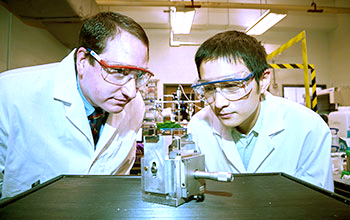Multimedia Gallery
Strain improves semiconductor material performance (Image 2)
Michael Pettes (left), assistant professor of mechanical engineering at the University of Connecticut, and Ph.D. student Wei Wu check a specially engineered device they created to exert strain on a semiconductor material only six atoms thick. [Image 2 of 2 related images. Back to Image 1.]
More about this image
Researchers in the University of Connecticut's (UConn) Institute ¬¬ thin semiconductor material by stretching it, an accomplishment that could prove beneficial to engineers designing the next generation of flexible electronics, nano devices, and optical sensors.
In a recently published study, Michael Pettes, an assistant professor of mechanical engineering at UConn, reported that a six-atom thick bilayer of tungsten diselenide exhibited a 100-fold increase in photoluminescence when it was subjected to strain. The material had never exhibited such photoluminescence before.
The findings mark the first time scientists have been able to conclusively show that the properties of atomically thin materials can be mechanically manipulated to enhance their performance, Pettes says. Such capabilities could lead to faster computer processors and more efficient sensors.
Primary funding for this research was provided by a National Science Foundation (NSF) Faculty Early Career Development award (grant CBET 15-53987).
Learn more about this research in the NSF News From the Field story Strain improves performance of atomically thin semiconductor material. (Date image taken: April 2018; date originally posted to NSF Multimedia Gallery: Aug. 10, 2018)
Credit: Peter Morenus/UConn Photo
See other images like this on your iPhone or iPad download NSF Science Zone on the Apple App Store.
Special Restrictions: Note: Any commercial use of this image requires the photographer's permission.
Images and other media in the National Science Foundation Multimedia Gallery are available for use in print and electronic material by NSF employees, members of the media, university staff, teachers and the general public. All media in the gallery are intended for personal, educational and nonprofit/non-commercial use only.
Images credited to the National Science Foundation, a federal agency, are in the public domain. The images were created by employees of the United States Government as part of their official duties or prepared by contractors as "works for hire" for NSF. You may freely use NSF-credited images and, at your discretion, credit NSF with a "Courtesy: National Science Foundation" notation.
Additional information about general usage can be found in Conditions.
Also Available:
Download the high-resolution JPG version of the image. (10.7 MB)
Use your mouse to right-click (Mac users may need to Ctrl-click) the link above and choose the option that will save the file or target to your computer.

